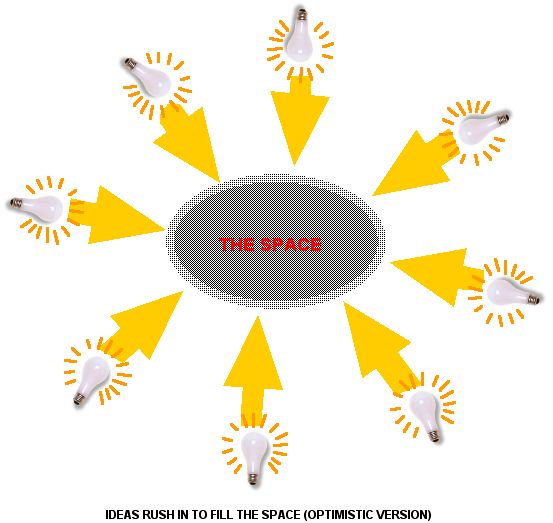|
2. Writing Through
| |
(v) CREATING INTO A SPACE |
There’s the kind of free-flowering inspiration that sets up a novel in the first place—if you didn’t love that part of the business, you’d hardly want to be a writer of genre fiction. But there’s also a more difficult kind of inspiration when you need to produce something to fill a space.
For example, some scenes are practical necessities, even though your story has no immediate use for them. For example, buying a ticket in order to to travel, putting on armour before a combat. Or, you have amazing dramatic ideas for event A and event C, but you can only move between them by way of scene B. You arrive at these scenes with no idea of how to make them interesting to the reader—or yourself. Here’s the toughest test: to create something interesting that also fits a pre-defined space.
 For example, in my steampunk novel Song of the Slums, the industrialised world is blanketed in foul, thick smog. Astor, who has lived in high country above the pollution, ends up escaping from Swale House in Brummingham into an atmosphere that's almost impossible to breathe until you adapt to it. Problem! because adapting would take time, probably up to a few hours, and the story doesn't allow that sort of time. There are things to happen outside as soon as Astor and Verrol escape. So I thought of an in-between chamber, like an airlock or decompression room for divers, a room you'd have to go through, closing one door before opening another, on the way in or out. Makes perfect sense as a way to stop the smog from invading the house. But how to keep Astor waiting in there for long enough to adapt to the choking foulness of the smog? For example, in my steampunk novel Song of the Slums, the industrialised world is blanketed in foul, thick smog. Astor, who has lived in high country above the pollution, ends up escaping from Swale House in Brummingham into an atmosphere that's almost impossible to breathe until you adapt to it. Problem! because adapting would take time, probably up to a few hours, and the story doesn't allow that sort of time. There are things to happen outside as soon as Astor and Verrol escape. So I thought of an in-between chamber, like an airlock or decompression room for divers, a room you'd have to go through, closing one door before opening another, on the way in or out. Makes perfect sense as a way to stop the smog from invading the house. But how to keep Astor waiting in there for long enough to adapt to the choking foulness of the smog?
That was the space - and what came to fill it was a neat escape trick. Astor and Verrol are already being pursued by Swale-men and servants as they race for the exit in a cart they've just hijacked. They enter the 'airlock' room and close the door behind them, then Verrol opens the outer door, into the smog outside. But they don''t continue their flight - they jump from the cart and climb up into the rafters, sending hourse and cart on their way instead. When the Swale-men and servants burst into the 'airlock' room, they see the outer door open, hear the disappearing clatter of hooves and wheels, immediately assume the escapees have done the expected thing and chase after them. Then Astor and Verrol can bide their time, wait for nightfall and slip out unnoticed - also after Astor has adjusted to breathing in the smog!l
I love it when things come together as if they were always meant to be! I'd have chosen that escape trick even if there hadn't been an ulterior motive for it! In moments like that, I really get the feeling that the story's on my side!
What you hope to avoid is the blatant fill-in, the mere bridge. The fact that you didn’t originally want this scene should disappear into the history of the making of the novel. By the time you write it and the reader reads it, this scene should be as much wanted as any other scene. It should have become so interesting that you’d be eager to write it even if the rest of the novel didn’t exist.
I believe that everything in a novel should be loved and wanted for its own sake. Or—nothing in a novel should be there in the service of some purpose outside itself. That’s my mantra, and I’m sticking to it.
So how do you get an inspiration that fits a pre-defined space? I couldn’t say where ideas come from in the first place, so I can’t answer this one either. All I know is that something always comes if you hold your mind open. Trawl around, like a net in the sea, and wait. Patience is a virtue!

|
|





